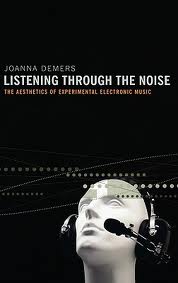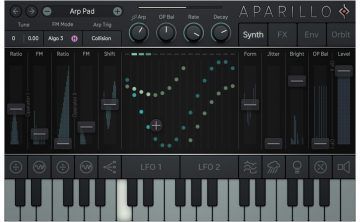by Dave Maier
Joanna Demers – Listening Through the Noise: The Aesthetics of Experimental Electronic Music (Oxford University Press, 2010)
 When I tried, in 1981, to interest my undergraduate music professors in progressive electronic music, they didn't get it: anything with notes was “harmonically simple” (“it hess to do with analeetical levelss”, explained one prof), and anything without notes left them completely at sea. Apparently “musicology” meant the theory, not of music generally, but of Western classical music in particular. For anything else you want “ethnomusicology”, which turned out to be basically a subset of anthropology, dominated by scrupulously objective descriptions of Javanese gamelan, Ghanaian drumming, and so on (worthy music all, but not what I was talking about).
When I tried, in 1981, to interest my undergraduate music professors in progressive electronic music, they didn't get it: anything with notes was “harmonically simple” (“it hess to do with analeetical levelss”, explained one prof), and anything without notes left them completely at sea. Apparently “musicology” meant the theory, not of music generally, but of Western classical music in particular. For anything else you want “ethnomusicology”, which turned out to be basically a subset of anthropology, dominated by scrupulously objective descriptions of Javanese gamelan, Ghanaian drumming, and so on (worthy music all, but not what I was talking about).
I guess that's not too surprising. If you are trained from the age of five to think about music solely in terms of melody and harmony, or at least pitch and duration, then you should be equally flummoxed both by music which lacks these things entirely, and – perhaps even more – by that which subordinates them to other things, like sound texture and spatial location. So I have not been expecting much analytic help from musicological quarters. However, I am pleased to report that Joanna Demers's recent book displays an amazing degree of familiarity – for an academic musicologist at any rate – with the full range of contemporary electronic music and sound art.
Listening Through the Noise is not a work of criticism, but of aesthetic theory, and the discussion is a bit abstract at times, perhaps in order to avoid drowning the reader in technical detail. However, as appropriate to the subject as this abstraction is, Demers renders her subject approachable through the analysis of a wide-ranging array of examples, and her writing is clear and accessible. This is partly because she is laying the groundwork for future elaboration rather than making a definitive statement, but as a level-headed introduction to this difficult topic, this book is hard to beat.
Yet I think we're still talking about baby steps. Impressed as I was to see approving references in an academic book to the likes of Celer, Basic Channel, and Tetsu Inoue, a quick look at the discography and index reveals huge, gaping holes. Some are excused by the focus on aesthetic theory rather than history or criticism, but to see what progress has actually been made here, we need to take a closer look.
Read more »
 Last time I posted a mix of Jon Hassell’s music, a little under his own name and a lot of collaborations. This time we’ll look at (my take on) Jon’s influence on others; but we’ll hear a bit more from Jon himself as well.
Last time I posted a mix of Jon Hassell’s music, a little under his own name and a lot of collaborations. This time we’ll look at (my take on) Jon’s influence on others; but we’ll hear a bit more from Jon himself as well. 
 If you listen to that track as featured in the mix, my judgment may seem a little harsh. The track is on the static side, but that’s hardly a fault in the context: the textures are lovely, and there’s plenty of movement; and at under four minutes it can’t really be said to overstay its welcome. A minor work, perhaps, but as a brief linking interlude it works perfectly well. So what’s the problem?
If you listen to that track as featured in the mix, my judgment may seem a little harsh. The track is on the static side, but that’s hardly a fault in the context: the textures are lovely, and there’s plenty of movement; and at under four minutes it can’t really be said to overstay its welcome. A minor work, perhaps, but as a brief linking interlude it works perfectly well. So what’s the problem? Another not-necessarily-the-best-of-the-year mix, but there do seem to be a number of 2019 releases. Warning: this one’s pretty drony, so don’t be driving or anything. Sequencers next time, I promise! (A few anyway.)
Another not-necessarily-the-best-of-the-year mix, but there do seem to be a number of 2019 releases. Warning: this one’s pretty drony, so don’t be driving or anything. Sequencers next time, I promise! (A few anyway.) We’ve seen a couple of these artists before. FernLodge is this guy Joe from Canada, whose music is (as is all of this music actually; follow the links) available on Bandcamp. However, while most artists, even when giving their music away for free, allow you to “name your price” (which in turn allows you, if your price isn’t zero, to put that music into your Bandcamp “collection,” available to download whenever you want), Joe simply sets the price at “free” (which means you can’t put it into your online collection even if you want to). As you can tell by listening, Joe is being way too modest, as
We’ve seen a couple of these artists before. FernLodge is this guy Joe from Canada, whose music is (as is all of this music actually; follow the links) available on Bandcamp. However, while most artists, even when giving their music away for free, allow you to “name your price” (which in turn allows you, if your price isn’t zero, to put that music into your Bandcamp “collection,” available to download whenever you want), Joe simply sets the price at “free” (which means you can’t put it into your online collection even if you want to). As you can tell by listening, Joe is being way too modest, as  In the Third Essay of On the Genealogy of Morality, Nietzsche levels a powerful attack on the modern Platonistic conception of mind and nature, urging us to reject such “contradictory concepts” as “knowledge in itself,” or the idea of “an eye turned in no particular direction, in which the active and interpreting forces, through which alone seeing becomes seeing something, are supposed to be lacking.” More recently, Donald Davidson’s attack on the dualism of conceptual scheme and empirical content, and thus of belief and meaning, requires us to see inquiry into how things are as essentially interpretative.
In the Third Essay of On the Genealogy of Morality, Nietzsche levels a powerful attack on the modern Platonistic conception of mind and nature, urging us to reject such “contradictory concepts” as “knowledge in itself,” or the idea of “an eye turned in no particular direction, in which the active and interpreting forces, through which alone seeing becomes seeing something, are supposed to be lacking.” More recently, Donald Davidson’s attack on the dualism of conceptual scheme and empirical content, and thus of belief and meaning, requires us to see inquiry into how things are as essentially interpretative.